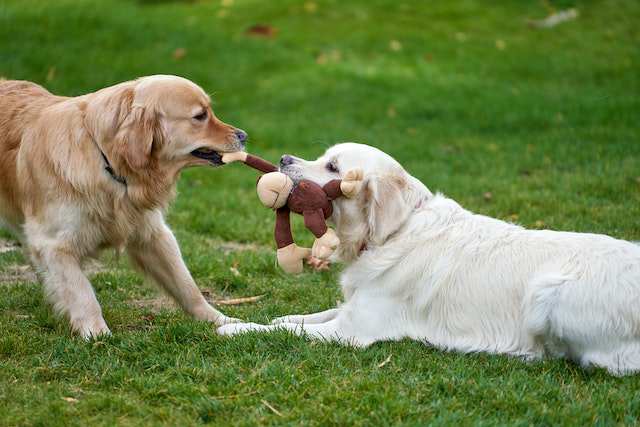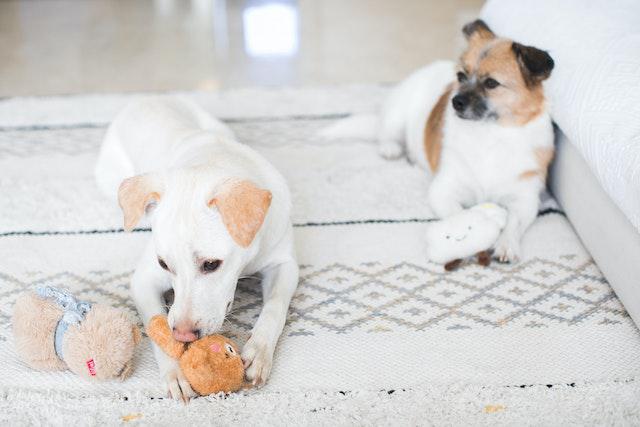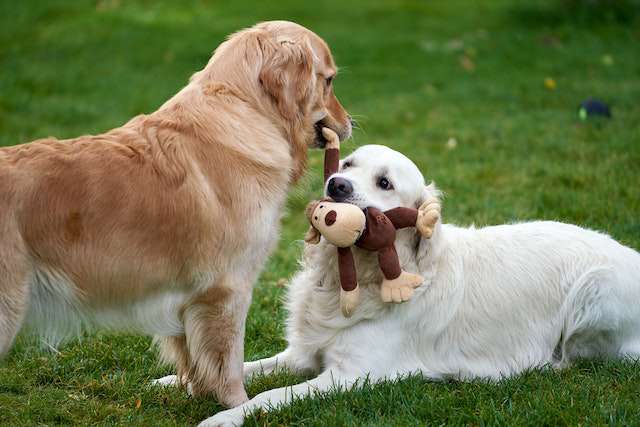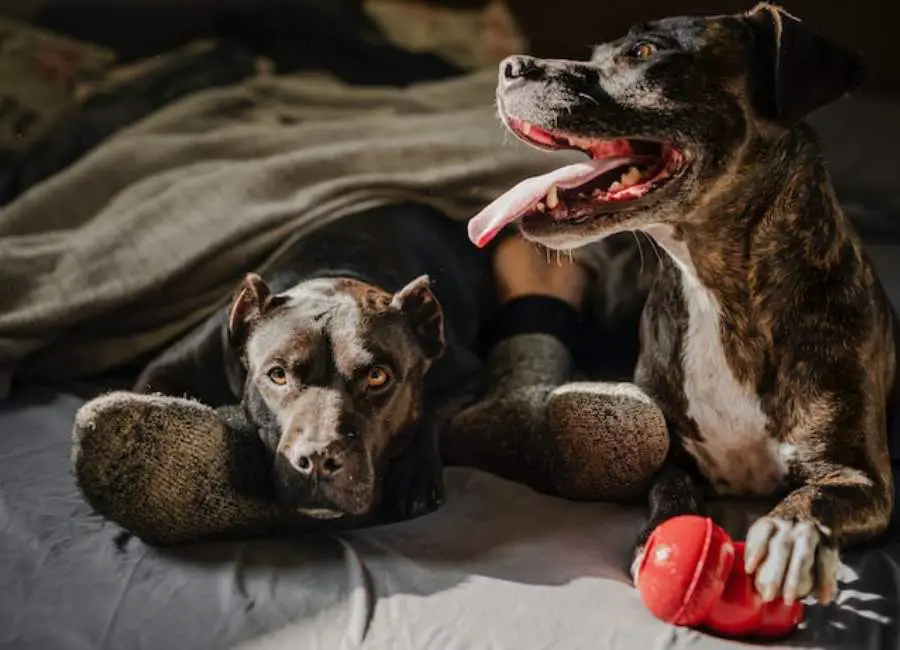Why is my dog possessive of toys with other dogs? Let’s find out together…
Have you ever noticed that your furry friend can get a little possessive when it comes to their toys? Trust me, you’re not alone.
In this blog post, we’ll dive deep into the fascinating world of dogs and their toy possessiveness, exploring the reasons behind this behavior and how we can help them learn to share and play nicely with other pups.
Why is my Dog Possessive Of Toys With Other Dogs
Dogs can be possessive of toys with other dogs due to an instinct to guard resources, this behavior is often related to dominance or territoriality.
It is important to provide proper socialization and training to address possessiveness and promote positive interactions between dogs.
Consulting with a professional dog trainer or behaviorist can help address this issue effectively.
Signs of Possessiveness in Dogs

Signs of possessiveness in dogs can include resource guarding, where a dog becomes protective over food, toys, or other objects. This may manifest as growling, snapping, or even biting when someone approaches their possessions.
Another sign is territorial behavior, where a dog becomes possessive over specific areas, such as their bed or favorite spot in the house.
Dogs displaying possessiveness may also exhibit excessive possessive behaviors towards their owners, such as following them closely, refusing to share attention, or becoming anxious when separated.
It is important to address possessive behavior in dogs through training and positive reinforcement to ensure a safe and harmonious environment.
Why Some Dogs Are More Possessive Than Others

The following are some common reasons why some dogs are more possessive than others:
Lack of Socialization
One common reason for possessiveness in dogs is a lack of proper socialization during their critical developmental period. Dogs that have not been exposed to a variety of people, animals, and environments may be more prone to possessive behavior.
Resource Guarding
Resource guarding is another common reason for possessiveness in dogs. This behavior occurs when a dog perceives certain items, such as food, toys, or even their owners, as valuable resources that need to be protected. Dogs may growl, snap, or even bite to defend these resources.
Insecurity or Fear
Some possessive behaviors can stem from insecurity or fear. Dogs that lack confidence may feel the need to guard their possessions as a way of maintaining control and security in their environment.
Overprotection
Dogs that have a strong bond with their owners may exhibit possessive behaviors as a way of protecting them. This can manifest as guarding behavior towards other people or animals that come near their owners.
Lack of Training and Boundaries
Dogs that have not received proper training and guidance may be more prone to possessive behaviors. Without clear boundaries and consistent reinforcement, dogs may believe that they have the right to control and guard their resources.
Previous Negative Experiences
Negative experiences in the past, such as trauma or abuse, can contribute to possessive behavior in dogs. These experiences can make dogs more wary and protective of their belongings.
Breed Predisposition
Certain dog breeds may have a higher tendency towards possessive behaviors. This can be due to their genetic predispositions, such as being bred for guarding or protection purposes.
Medical Issues
In some cases, possessive behaviors in dogs can be linked to underlying medical issues. Pain or discomfort can contribute to heightened anxiety and possessive behavior.
Reinforcement of Possessive Behaviors
Lastly, unintentionally reinforcing possessive behaviors can contribute to their persistence. If a dog’s possessive behaviors are consistently rewarded or go unaddressed, they are more likely to continue.
The Dangers of Unchecked Possessiveness in Dogs
Unchecked possessiveness in dogs can pose serious dangers to both humans and other animals.
This behavior can lead to aggression and territoriality, making it difficult for the dog to interact safely with others.
Unchecked possessiveness can also result in resource guarding, where the dog becomes aggressive when someone approaches its possessions, such as food or toys.
This behavior can escalate and potentially lead to bites or attacks. Dog owners must address possessiveness early on through proper training and socialization to ensure the safety and well-being of both the dog and those around it.
How to Address Dog Possessive Of Toys With Other Dogs
When addressing a dog that is possessive of toys around other dogs, it is important to follow these steps.
Firstly, provide each dog with their own designated toys to prevent resource guarding. Secondly, gradually introduce the dogs to each other’s toys in a controlled and supervised environment.
Thirdly, use positive reinforcement techniques to reward calm and non-possessive behavior around toys. Fourthly, redirect the possessive dog’s attention to other activities or toys to distract from possessive behavior.
Lastly, seek professional help from a certified dog trainer or behaviorist if the possessive behavior persists or escalates.
Tips for Managing Possessiveness in Dogs

Managing possessiveness in dogs is important for their well-being and the safety of those around them.
Here are some common tips for managing possessiveness in dogs:
- Recognize the signs: It is crucial to identify the signs of possessiveness in dogs, such as growling, snapping, guarding behavior, or resource guarding. Understanding these signs will help you address the issue effectively.
- Avoid confrontations: When a dog displays possessive behavior, it’s important to avoid confrontations or punishments. These actions can escalate the situation and make the possessiveness worse.
- Create a positive association: Encourage your dog to associate positive experiences with the things they guard. For example, when they possess a toy, offer them a treat or praise to create positive associations and reduce possessiveness.
- Train basic obedience: Teaching your dog basic obedience commands, such as “sit,” “stay,” and “leave it,” can help manage possessiveness. These commands can redirect their attention and provide you with control in potentially possessive situations.
- Establish boundaries: Set clear boundaries and rules for your dog. Consistency is key. Make sure they understand what is allowed and not allowed, and reinforce positive behavior.
- Gradual desensitization: Gradually expose your dog to situations or triggers that trigger possessiveness. Start with low-intensity situations and gradually increase the difficulty level. This desensitization process helps them learn new, non-possessive behaviors.
- Provide mental and physical stimulation: Dogs who are mentally and physically stimulated are less likely to display possessive behaviors. Engage them in regular exercise, and play, and provide interactive toys to keep them occupied and mentally stimulated.
- Reward non-possessive behavior: Whenever your dog displays non-possessive behavior, reward them with treats, praise, or playtime. Positive reinforcement will encourage them to exhibit more desirable behaviors.
- Seek professional help if needed: If your dog’s possessiveness becomes challenging to manage or if there are safety concerns, it’s important to consult with a professional dog trainer or behaviorist. They can provide guidance tailored to your dog’s specific needs.
Remember, managing possessiveness in dogs requires patience, consistency, and positive reinforcement. Each dog is unique, and it may take time to see improvements.
With proper management and training, you can help your dog develop healthier behaviors and create a harmonious living environment.
The Role of Socialization in Reducing Possessive Behavior in Dogs
Early socialization plays a crucial role in reducing possessive behavior in dogs. Exposing puppies to various people, animals, and environments at a young age helps them learn to share and be comfortable in different situations.
This exposure helps prevent possessiveness over toys, food, or territory as they grow older.
Proper socialization helps dogs develop confidence, adaptability, and positive behavior patterns, which can significantly reduce possessive tendencies.
Investing time and effort in early socialization sets a strong foundation for a well-rounded and balanced dog, fostering harmonious relationships with both humans and other animals.
Read more about why dogs bite their owners.
Frequently Asked Questions
Why is my dog possessive of toys when other dogs are around?
Dogs can be possessive of their toys when other dogs are around due to a nan instinct to protect their resources. They may feel threatened by the presence of another dog and want to ensure that their prized possessions are not taken away.
How can I address my dog’s possessiveness of toys with other dogs?
It’s important to establish clear boundaries and rules when it comes to toy sharing. Start by teaching your dog basic commands like “leave it” and “drop it.” Gradually introduce other dogs into the playtime and reward positive behavior. With time and consistent training, your dog can learn to share toys more peacefully.
What are the signs that my dog is possessive of toys with other dogs?
Some common signs of possessiveness include growling, snapping, or guarding toys from other dogs. Your dog may also display stiff body language, tense facial expressions, or become overly focused on the toy. It’s crucial to address these signs early on to prevent any potential conflicts.
Can the possessiveness of toys with other dogs lead to aggression?
Yes, the possessiveness of toys can escalate into aggression if not addressed properly. It’s essential to nip this behavior in the bud to prevent any potential harm to other dogs or humans. Seek guidance from a professional dog trainer or behaviorist if needed.
Is it normal for dogs to be possessive of toys with other dogs?
Some level of possessiveness is considered normal in dogs, as they have an innate instinct to protect their resources. However, it’s crucial to ensure that this possessiveness doesn’t escalate to aggressive behavior or cause distress to other dogs.
Can I train my dog to overcome the possessiveness of toys with other dogs?
Yes, with patience, consistency, and positive reinforcement training, you can help your dog overcome possessiveness and learn to share toys with other dogs. It’s important to create a safe and positive environment for all dogs involved and provide plenty of opportunities for socialization and play.
Read more about anxiety in dogs and signs of a happy dog.
Conclusion
So, if you’ve ever wondered why your dog gets possessive of their toys around other dogs, you’re not alone! It turns out that this behavior is acutely common among our furry friends.
Whether it’s due to resource guarding or a nan instinct to protect their belongings, it’s important to understand that this behavior can be managed with proper training and socialization.
So, next time you see your pup getting a little possessive, remember to approach the situation calmly and work on teaching them to share their toys with their fellow canine companions. Happy playing!


